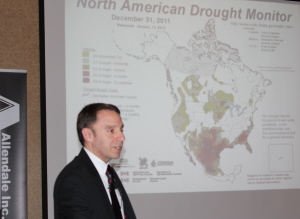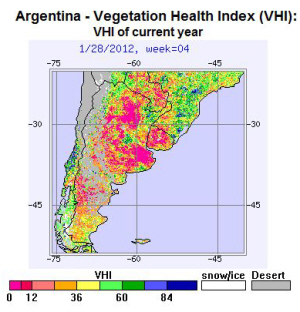



Expert Presents 2012 Global Weather Outlook
ANALYSIS - Drew Lerner, president and senior agricultural meteorologist of World Weather, recently presented global weather expectations for 2012 to US grain farmers and livestock producers at the Allendale Ag Leaders Outlook Conference held in Crystal Lake, Illinois, USA, writes Sarah Mikesell, ThePoultrySite senior editor.South America
Impressive dryness occurred in Argentina during December. However, temperatures were not far above average which may have saved some crop stress from getting as bad as 2008 levels, Lerner said. But the crop was too dry, which has contributed to the early January production cuts despite anticipated rainfall.
Argentina's summer corn and soybean production region received about 50 per cent less than normal precipitation in December, he said.

"But rains provided some relief in January and now Argentina has recently had moisture," he said. "The topsoil is plenty moist and the crops are no longer suffering. So Argentina may be beyond the point of damaging losses. With that said, the damage already done prior to the rains in Argentina is rather significant."
Those watching South America know from a realistic point of view on rainfall, we're probably past the peak of damage. However, the unknown is how much damage it already did. Lerner said by looking at the data, it clearly suggests the damage has been significant.
Brazil rainfall was below average in the south during December, but the lack of excessive heat and the timeliness of what rain did fall left crops in better shape than those in Argentina. The next weeks will be critical for supporting the best yields but rain must continue to fall in a timely manner.
"There's not that much problem in Brazil today," he said. "The dryness early on was getting kind of bad, but they kept getting timely rains, and so it didn't push them over the edge."
In contrast, weather conditions have been too wet from parts of Sao Paulo and Minas Gerais into a part of Mato Grosso where there is a need for sunshine and warmer temperatures to induce the best crop conditions.

Lerner said the rain event that occurred in Argentina a few weeks ago managed to bring some moisture into Brazil. And more recent rains have significantly improved soil moisture.
"It doesn't mean Brazil won't have dryness later on, but it does suggest that the worst of the near-term damage has probably passed," he said. "So, again like Argentina, it may be beyond the peak of the worst conditions in that country."
China
China is a bright spot on the map - currently having absolutely perfect weather, said Lerner.
"I don't look for any problems with the rapeseed or wheat crops; those are looking really good," he said. "They've got plenty of soil moisture right now. The spring season will turn drier, but it will not impact their rapeseed or southern wheat. However, it might impact the northern wheat, but it's mostly irrigated so it should not be a big issue."
Dryness will begin in interior southern China late winter and will shift to east-central parts of the country during the heart of spring. The dryness will be a byproduct of delayed northward advancing rainfall.
Temperatures may be a little cooler than usual in the spring over northeastern parts of the country but should warm in the second half of the season. Eventually dryness in east-central China will shift to some northeastern crop areas later in the spring season. Southwestern China will trend wetter than usual.
India
India has not had much rain in recent weeks and hasn't had any rain at all in some places since planting. They plant wheat, rapeseed, mustard, lentils, sorghum, dry beans and peas, and are in their winter production season. Almost all of their crops are irrigated, but their best yields occur when it rains - on top of their irrigation.
Lerner said because they haven't had timely rains, it doesn't mean they're going to have a bad crop. Rather, it just means that it isn't going to be as good a crop as it would have been had it rained. However, any prolonged dryness and heat could possibly have a negative impact on production.
India's wheat crop is not expected to get any rain for the next few weeks, but should get a little more precipitation as we move forward into February and March.
Rainfall is expected to be near to above average in northern India during the reproductive season. Temperatures are not expected to be hot, although a warmer than usual bias will likely evolve in March.
"Soil moisture is pretty dry, but remember, India is a very arid place in the wintertime, and that's why all of the crops are irrigated," he said.

The monsoon forecast for 2012: If La Niña behaves as expected, the monsoon should be around early in the summer, and then dissipate later in the summer. Timeliness should continue in the precipitation pattern so that any negative impact on production should be minor. Eastern areas will be quite wet this summer.
India should do very well with rainfall until the latter part of the summer. In August and September, expect a little less precipitation. It may turn drier in some of the western parts of the country.
Europe
Overall, Europe's soil moisture is favorable for much of the continent, but there are two areas that need improved precipitation. First is Spain and second is the southeastern part Europe, including the Danube River Basin, Romania, Bulgaria and portions of Serbia.
"These areas were extremely dry through the autumn, and crops aren't doing well," he said. "It extends all the way back to the west into parts of southeastern Europe. They are expected to have very poor winter crop production this year, so a lot of pressure will be on the spring crops."
If La Niña does hang on through the spring and into summer, spring crops could see trouble with low moisture. But it could be a double-hit if winter crops and summer crops are stressed due to dry conditions.
Russia and Ukraine
Dryness remains from the drought of 2010 in Russia's lower-most Volgo River Basin and western Kazakhstan. The remainder of Russia and Ukraine have recovered favorably from Autumn 2011 dryness.
The Ukraine winter crops were very, very poorly established in the fall which will result in a very small winter rye and winter wheat crop, Lerner said. He expects they will plant a spring variety to try to make up the difference. It will be imperative that timely rains occur this spring to give winter crops a chance to recover and to ensure spring crops get planted and established favorably.
"If La Niña lasts through the summer season, Russia and La Niña do not get along well and sometimes Ukraine doesn't either," he said. "The two just don't mix well, and we should expect some kind of a problem over there with their crops as well."
Turkey
Turkey was really dry last autumn and the wheat crop is suffering from the stress. However, they've recently received some rain and conditions are improving.
Further ReadingRead Part 1 - North America: Where's the Snow? of Lerner's weather forecast by clicking here. |












